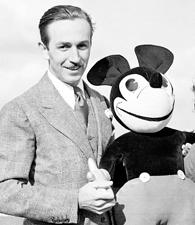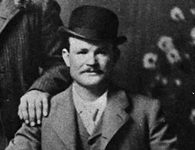Although Walt Disney’s first illustration company went broke, the ambitious animator took his sketchbook to Hollywood where he made it big with a mouse named Mickey. Disney pioneered the field of animation, creating the first sound-synchronized cartoon, the first cartoon in color, the first full-length feature cartoon and, of course, the first cartoon theme park.
Walt Disney’s Early Days
Walt Disney was born in Chicago, Illinois, on December 5, 1901, to Elias and Flora Call Disney. He and his four siblings moved to Marceline, Missouri, when Disney was in elementary school.
As a child, Walt Disney was interested in drawing, photography and vaudeville. In high school, he used his artistic talent as an illustrator for the school newspaper and attended night school at the Academy of Fine Arts, studying cartoon illustration.
After a brief stint at the Red Cross (he was fired when the organization discovered he was under age), Disney enrolled in the Kansas City Art Institute, where he met Ub Iwerks, who would become his partner and friend. The two established their own illustration company, which soon went bankrupt. They moved to Hollywood in 1923 and established a cartoon series called the “Alice Comedies,” which ran successfully from 1923 to 1927, with the financial support of Disney’s older brother, Roy.
One evening, while riding the train home from work, Walt doodled a mouse onto a piece of paper and named it “Mickey.” With illustration assistance from Iwerks, Disney created the Mickey Mouse series.
Sources in this Story
- Hollywood Renegades: Biographical Sketch of Walt Disney
- IMDb: Walt Disney Biography
- Just Disney.com: Walt Disney Biography
- The Museum of Broadcast Communications: Disney, Walt
- The New York Times: Disney Builds a ‘Lifestyle Brand’ That Isn’t Cartoonish
Disney’s Notable Accomplishments
Mickey Mouse was the first cartoon series to employ synchronized sound. In fact, the show wasn’t initially picked up, and was only produced when Disney added sound in “Steamboat Willie” (1929), using his own voice to narrate.
The Mickey Mouse series was a success, but Disney continued to create new cartoons, such as “Flowers and Trees” (1932), which was the first animated series in color and the first cartoon ever to win an Oscar.
Disney also pioneered the full-length animated film with “Snow White and the Seven Dwarfs,” which premiered in Los Angeles on December 21, 1937. In the next five years, Disney went on to create “Pinocchio,” “Fantasia,” “Dumbo” and “Bambi.”
Despite his prolific work, Disney was financially limited by the time-consuming and labor-intensive nature of animation. After World War II, he decided to expand his work into new fields beyond the film industry.
Through a partnership with ABC, Disney began building the amusement park he had long envisioned. In exchange for a weekly, hour-long television program and a percent of future profits, the network put $500,000 towards the construction of Disneyland.
Disney’s ABC show, which first aired on October 27, 1954, garnered record ratings for the network. In the meantime, Disneyland grossed $10 million within the first year of its opening in 1955. Walt Disney spent the remainder of his career hosting his own show and developing new series like “The Mickey Mouse Club” and “Zorro.”
The Man and his Work
- “Walt Disney: An American Original” by Bob Thomas
- “Sleeping Beauty”
- “Dumbo”
- “101 Dalmatians”
- “Sword in the Stone”
The Rest of the Story
On December 15, 1966, Walt Disney died of cancer at age 65. His animated work, like “101 Dalmatians” and “The Sword in the Stone,” has continued to entertain young people, and the business empire he founded has flourished.
The Disney legacy has multiplied in many ways. A modern Disney “lifestyle” brand includes a $3,900 designer wedding gown and a $6,000 chandelier modeled after the Art Deco design in Disney’s office. Los Angeles designer Charlotte Tarantola made a limited collection based on Snow White, telling The New York Times, “Anyone who is alive today has been touched by Disney in some way. If becoming partners with them can help my business, far out.”
This article was originally written by Isabel Cowles; it was updated December 5, 2017.











